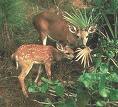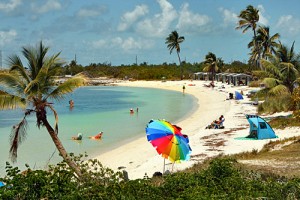Free or Almost Free* things to do in the Lower Florida Keys
The Florida Keys can be an expensive place to live and visit. This page will try to bring you some of the best, less expensive (* $10 or less for a family of 4), things to do. There are always cheap or free things to do such as window shopping, walking around the block, singing in the shower. That is not what this page will bring you. These Things To Do will have you telling everybody what a good time you had and many of you will never reveal the costs.
Lower Florida Keys
 National Key Deer Refuge Big Pine Key on Key Deer Boulevard off MM 30
National Key Deer Refuge Big Pine Key on Key Deer Boulevard off MM 30
Fees: Admission is free.
The Key deer are a wild species, and are not confined to any specific area. They are visible throughout Big Pine and No Name Keys, and are scattered on surrounding Lower Florida Keys islands. They are most active at dusk and dawn and remain in the confines of the cool pine rocklands during the heat of the day. Unfortunately, due to illegal feeding, Key deer can be found foraging on the sides of most roads and eagerly approach slow moving vehicles for hand-outs. Roadside feeding kills Key deer as it draws them to hazardous roadways, and concentrates populations facilitating the spread of parasites and disease. Begin your adventure at the Visitor Center in the Big Pine Key Plaza off Key Deer Boulevard.
Location: 179 Key Deer Blvd., Big Pine Key; Mile Marker 30 (on the bay)
The visitor center for this sprawling, 25-island refuge devoted to preserving the endangered Key deer is located in the Big Pine Key Shopping Center. Key deer are a variant of the Virginia white-tailed, reduced by the harsh environment to the size of a large dog (roughly 45-75 pounds). To actually see some deer, however, you’ll need to walk one of the two nature trails (Jack C. Watson and Blue Hole) located north on Key Deer Avenue or cruise slowly through the nearby residential areas on Big Pine and No Name Keys.
Facts about the Key deer:
The Key deer are the smallest of the 28 subspecies of Virginia white-tailed deer. Bucks range from 28 inches to 32 inches at the shoulder and weigh an average of 80 pounds. Does stand 24 to 28 inches at the shoulder and weigh an average of 65 pounds.
Experts think the Key deer migrated from the mainland to the Keys thousands of years ago. They are not found anywhere else in the world.
In 1922, the deer had a range of 60 miles from Duck Key to Key West. They are now isolated to a 6-mile area with most of the population on Big Pine Key.
The Key deer population dropped to less than 50 animals in the 1940s.
For more information click here Key Deer.
Big Pine Key Flea Market
Fees: Free to browse
Hours Open: The Flea Market is open to the public from 8am to 2pm (Saturday and Sunday) from the first weekend of October through the last weekend of July. Open until 3pm on Saturday January through March.
Rules: No animals of any kind or nature shall be permitted on or about premises (except service animals).
This is a pedestrian market. No bicycles, segways, golf carts or other forms of transportation are permitted (except wheelchairs and mobility scooters). No handbills or political matter. Speed limit is 5mph on any Flea Market property.
Directions: We are located at Mile marker 30.2 on US Hwy 1 just west of the only traffic light on Big Pine Key. Only 30 miles from Key West. 30250 US Hwy 1 Big Pine Key, FL 33043

Fees: $8.00* per vehicle. Limit 2-8 people per vehicle. $2.00* Pedestrians, bicyclists, extra passengers, passengers in vehicle with holder of Annual Individual Entrance Pass. $4.00* Single-occupant vehicle or motorcycle. * Plus $.50 per person Monroe County Surcharge.
Beaches
Bahia Honda has several white sandy beaches for you to enjoy.
Calusa is the smallest beach; it is located on the northwest side of the island. There are several small pavilions in this area and a bathhouse with outdoor, fresh water showers.
Loggerhead is the shallowest beach and is located on the south side of the island. It is known for the large shallow sand bar just a few feet offshore. It shares the same bathhouse with the Calusa beach.
Sandspur is the largest beach; it is located on the southeast end of the island. There are three large pavilions in the Sandspur area and a bathhouse with outdoor, fresh water showers.
Birding in the Lower Florida Keys
Bahia Honda is a very good place to see wading birds and shorebirds. There are shallow sand flats during low tide on the ocean side of the island where the birds feed and rest. A variety of shorebirds including Willets, Sanderlings, Ruddy Turnstones, Short-billed Dowitchers and Plovers may be seen along the shore feeding and resting. Several species of wading birds may be seen in the park as well. These include Great White Herons, Great Blue Herons, Tri-colored Herons, Great Egrets, Snowy Egrets and White Ibis. During the fall hawk migration, from mid-September to mid-November you will see a variety of hawks soaring overhead. The endangered White-crowned Pigeon can also be seen feeding and resting in the Poisonwood trees during the summer months.
